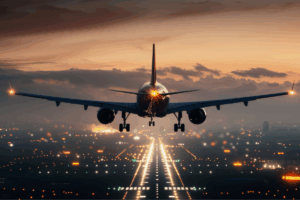It can be said that pioneers in aviation watched the graceful flight of birds for inspiration in developing early prototypes of modern aircraft. For example, the long, sweeping wings of today’s gliders and airplanes are reminiscent of those on eagles and albatrosses that carry them for long distances with minimal effort.
As much as we can attribute the rise of our industry to birds, our feathered friends can actually be a nuisance to safe runway operations. In 2023, the FAA reported that more than 47 bird strikes occur every day in the United States. That adds up to almost 15,000 incidents every year, most of which occur during takeoff and landing when birds are sucked into the jet engines or rotation propellers.
Fortunately, crew and passenger safety is rarely compromised by bird strikes. However, damage to an airplane due to these incidents can be costly. Birds colliding with an aircraft can destroy an airplane engine, disable ground steering, crumple an airplane’s nose cone, or blast a hole in a wing. In extreme cases, the damage can be so severe that an emergency landing may be necessary.
Although bird strike issues are often focused on the runways, aircraft hangars are another place where birds can potentially impact airport operations. An aircraft hangar’s high ceilings provide the perfect place for birds to nest and roost, leaving the hangar floors and aircraft subject to bird droppings, feathers, and other debris. If an airplane is being serviced with its cowling open, falling bird debris can cause damage to its delicate engine assemblies and parts. Additionally, bird droppings on the floor cause a slip-and-fall risk to workers and extra cleanup operations.
Developing bird control measures isn’t an easy task. Any solutions must not only minimize safety risks to airports but must also consider bird conservation efforts. As many bird species are protected under national wildlife laws, the FAA has collaborated with the U.S. Department of Agriculture’s Wildlife Services to develop guidelines that ensure compliance with wildlife protection laws while prioritizing aviation safety.
Here are some of the most effective bird control innovations being used today.
Habitat Management
Making changes to the open spaces near the airport can help deter birds from nesting in or visiting the area altogether. Some of the techniques used to manage the local habitat include:
- Maintaining grass between 6 and 12 inches in height to deter insects and rodents that serve as food for birds from collecting in the area, reducing its attraction to birds for feeding or nesting
- Trimming or removing trees, shrubs, and other vegetation to reduce habitats suitable for nesting birds, forcing them to collect in a location away from the airfield
- Placing floating objects in nearby ponds to help cover water that attracts birds
- Installing netting in hangars to block birds from roosting in the rafters
Live Animal Deterrents
Many airports employ licensed falconers with trained falcons or hawks to patrol the runway area. These birds of prey are the natural predators of many bird species and will scare them away simply through their presence.
Other airports use trained dogs, such as border collies, to chase birds from the area, preventing them from feeding, nesting, and collecting close to the airport. This method requires skilled management of the dogs so the birds don’t flee toward the tarmac to potentially collide with aircraft.
Drones
Many airports utilize drone technology to patrol the area and scare birds away. These drones can be equipped with noisemaking devices to deter birds from approaching.
Drone birds are a newer technology introduced to airports as a bird control tool. These remote-controlled robotic devices resemble the appearance and weight of a bird of prey. It uses a combination of realistic wing and silhouette movements that trigger the instincts of smaller birds, incenting them to stay clear of the patrolled area.
Radar Systems
Bird-detection radar systems track the movement and density of bird flocks in real time. Air traffic controllers can respond to the presence of birds by delaying aircraft takeoff or directing the plane to a different runway.
Read More: The Importance Of Reliable Power And Control Systems In Airport Lighting
Automated Wildlife Detection & Monitoring Systems (AWDMS)
This high-tech solution to bird management uses a combination of cameras and sensors to detect the presence of birds and other wildlife in the vicinity of the runway and automatically trigger tech-based deterrent systems, such as:
- Pyrotechnics, including flares and bangers that produce bright flashes of light or loud noises to scare the birds away
- Propane cannons that mimic gunshots, which many birds perceive as a threat
- Green lasers, creating a visual disturbance that drives birds away
- Bioacoustics that uses pre-recorded bird distress calls or predator sounds that will alert the incoming birds to danger
If you have questions about bird control technology or other aspects of your airport lighting and power systems, talk to the experts at Airport Lighting Company. Our technicians will always give you their best recommendations to ensure your runway and taxiway lighting operations are set up for safety, efficiency, and success.
Call Airport Lighting Company For The Latest In Airport Lighting Technology
The Airport Lighting Company team is standing by to answer your questions about how our tech-based products can help improve the safety, reliability, and efficiency of your runways. Call 315-682-6460 for fast, friendly service you can count on.


